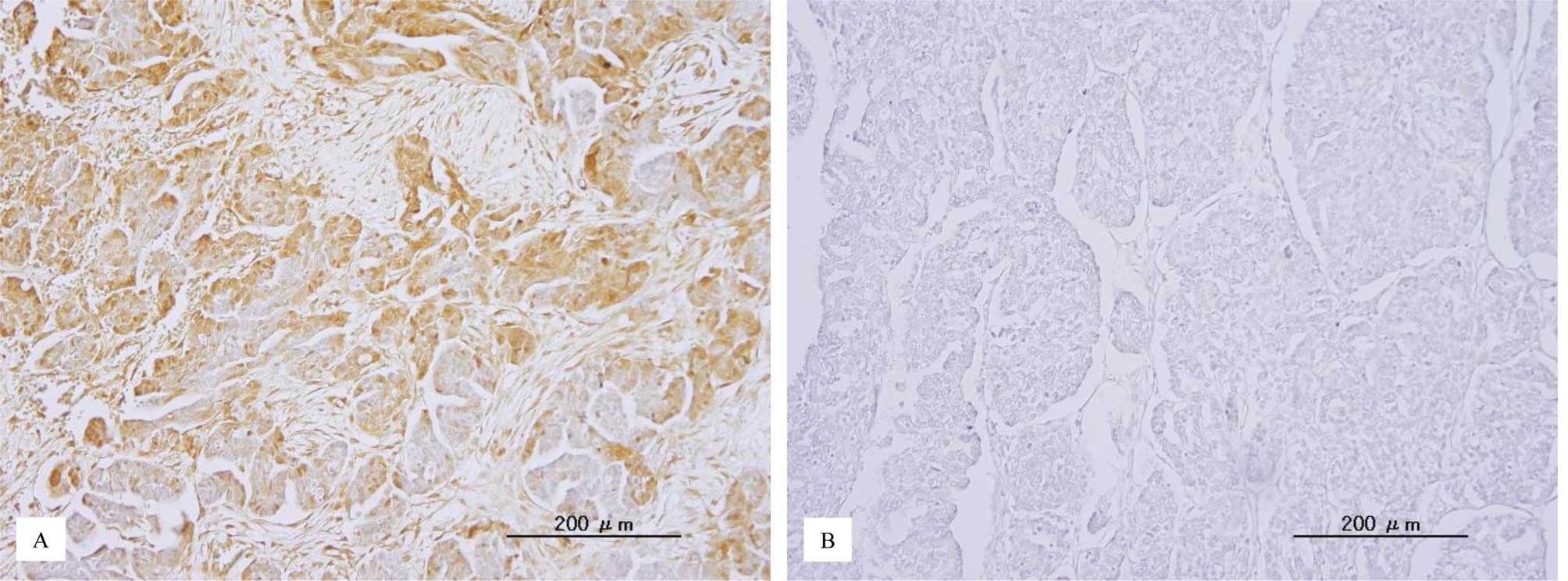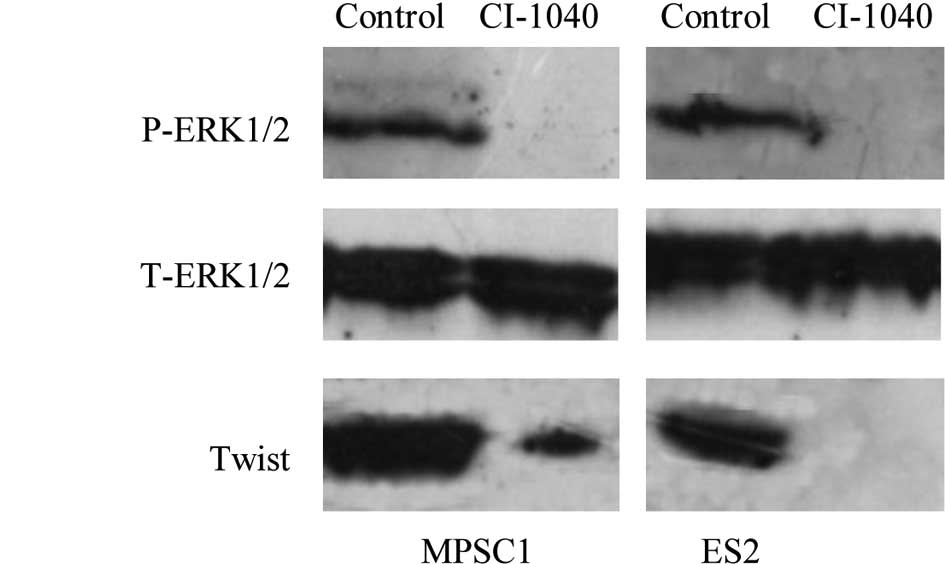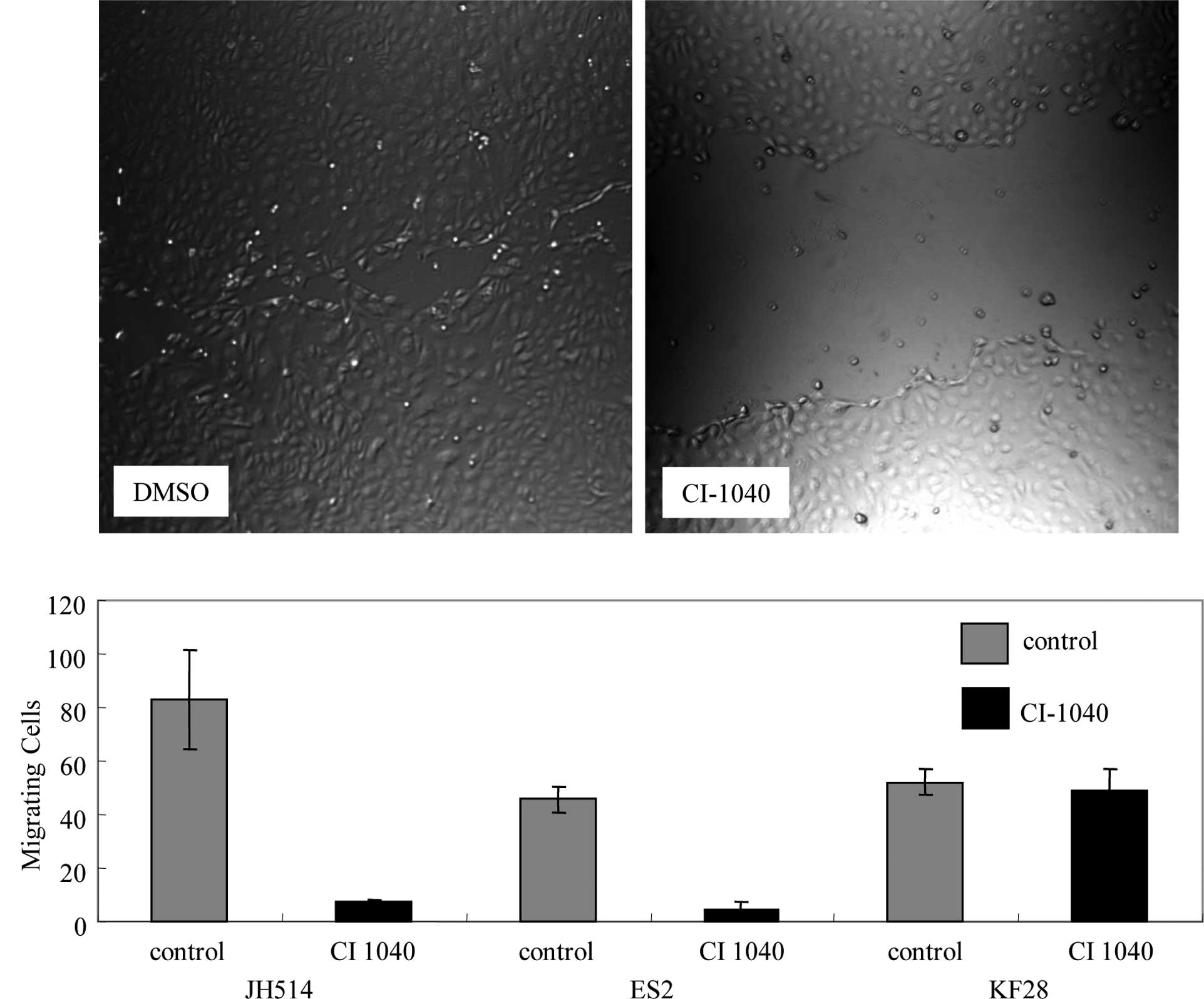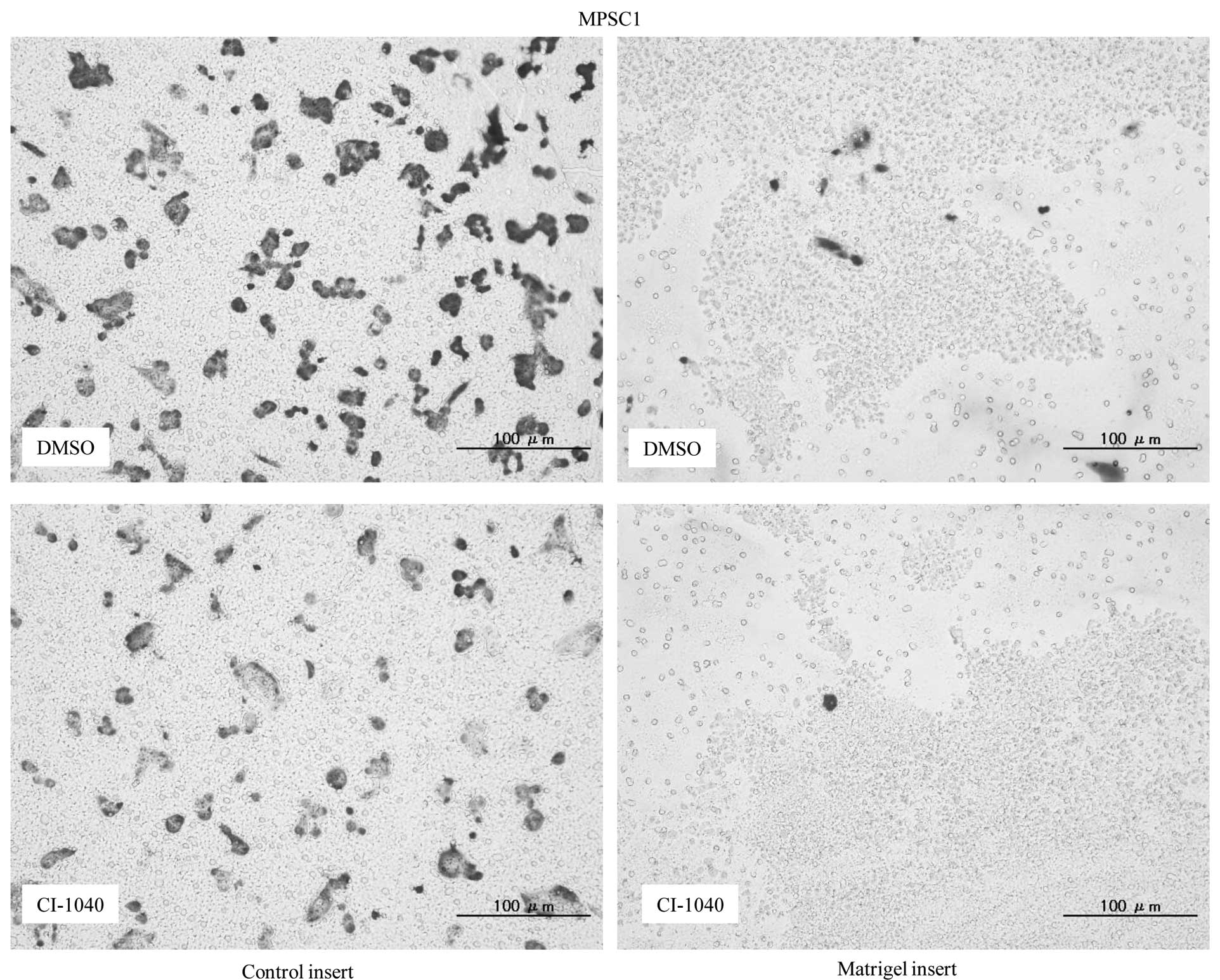MEK inhibition suppresses cell invasion and migration in ovarian cancers with activation of ERK1/2
- Authors:
- Published online on: July 1, 2010 https://doi.org/10.3892/etm_00000093
- Pages: 591-596
Abstract
Introduction
Ovarian cancer is the most lethal gynecological malignancy in the world (1). Its frequency has increased dramatically in the last decade. Despite the advent of newer screening tools, the majority of patients have peritoneal dissemination and distant metastasis at the time of diagnosis. With disseminated disease, treatment is often unsuccessful and the overall survival is low. Therefore, stage is one of the most important factors for determining prognosis (2). The identification of an invasion-related molecule associated with the early and rapid spread of ovarian cancer is the current focus of many investigators.
First-line chemotherapy with platinum drugs and taxanes yields a response rate of over 80%, but almost all patients relapse, and in nearly all patients, recurrent disease is incurable. Although there are well-established surgical and chemotherapeutic treatments for primary ovarian cancer, there is significant opportunity to develop drugs targeting specific molecular pathways to improve survival in recurrent disease. To do so requires a thorough understanding of the molecular pathways of ovarian carcinogenesis.
Several genetic alterations are associated with ovarian carcinogenesis, the most frequent of which are mutations in P53, KRAS and BRAF (3,4). Mutations of either BRAF or KRAS lead to constitutive activation (phosphorylation) of their downstream target, mitogen-activated protein kinase (MAPK), also known as extracellular signal-regulated protein kinase (ERK) (5,6). These mutations are correlated with overexpression of activated ERK1/2 in ovarian serous tumors (7). Phosphorylation of ERK1/2 activates downstream cellular targets (8,9), including a variety of cellular and nuclear proteins.
The RAS/RAF/MEK/MAPK signaling pathway plays a major role in various cellular activities including proliferation, differentiation, apoptosis, angiogenesis and migration (10–15). Suppression of MAPK activity by inhibitors, dominant-negative MEK1 mutants and anti-sense nucleotides reduces the migratory ability of certain cell types in response to extracellular growth stimulation (16–20). Given the important role of MAPK in cell function, we investigated whether the RAS/RAF/MEK/MAPK pathway is involved in the metastasis of ovarian cancer. In this study, we assessed the activation of MAPK in ovarian cancer tissues and examined the effects of a MEK inhibitor on cell motility and invasion.
Materials and methods
Tissue samples
Formalin-fixed, paraffin-embedded tissue samples of 88 ovarian cancers, including 45 serous, 10 mucinous, 10 clear-cell and 23 endometrioid carcinomas, were used in this study. The samples were obtained from the Department of Obstetrics and Gynecology of the Shimane University Hospital. Diagnosis was based on a conventional morphological examination of H&E-stained sections, and tumors were classified according to the WHO classification. Tumor staging was performed according to the International Federation of Gynecology and Obstetrics (FIGO) classification. The clinicopathological characteristics of the patients included in this study are summarized in Table I. All patients were primarily treated with cytoreductive surgery and adjuvant platinum and taxane chemotherapy (CBDCA AUC5, 175 mg/m2 paclitaxel or 70 mg/m2 docetaxel). All cases received 6–12 courses of this regimen. The acquisition of tumor tissues was approved by the Shimane University Institutional Review Board. The paraffin tissue blocks were organized into tissue microarrays, which were made by removing 3-mm diameter cores of tumor from each block. Selection of the area to core was made by a gynecologic oncologist (K.N.) and pathology technician (K.I.) and was based on a review of the H&E slides.
Table I.Association between p-ERK1/2 expression and clinicopathological factors in patients with ovarian cancer. |
Cell culture and cell lines
ES2 (clear-cell carcinoma) human ovarian cancer cell lines were obtained from the American Tissue Culture Center (Rockville, MD, USA). The human ovarian carcinoma cell line KF28 (serous carcinoma) was a kind gift from Dr Yoshihiro Kikuchi (Ohki Memorial Kikuchi Cancer Clinic for Women, Saitama, Japan) (10). The MPSC1 cell line was established from a low-grade serous carcinoma and was a kind gift from Dr Le-Ming Shih (Johns Hopkins Medical Institutions, Baltimore, MD, USA).
Immunohistochemistry
Expression levels of the active (phosphorylated) form of ERK1/2 and Twist were assessed by immunohistochemistry. The antibody used in this study was a rabbit polyclonal antibody that reacted exclusively with phosphorylated ERK1/2 (p-ERK1/2; Cell Signaling Technology). After antigen retrieval in a sodium citrate buffer, slides were incubated overnight at 4°C with antibodies to p-ERK1/2 (Cell Signaling Technology) and Twist (Santa Cruz Biotechnology, Santa Cruz, CA, USA) at dilutions of 1:1,000 and 1:100, respectively. This was followed by incubation with a biotinylated linker and streptavidin-horseradish peroxidase (LSAB2 System-HRP; Dako Cytomation, Carpinteria, CA, USA). The signals were visualized using ABC+ (Dako Cytomation) as the substrate-chromagen at room temperature for 10 min. Sections were counterstained with hematoxylin and mounted. The percentage of positive cells was estimated by randomly counting ∼500 tumor cells from three different high-power fields (x40) within one specimen. A positive reaction was defined as discrete localization of the brown chromagen in the nucleus or cytoplasm. Slides for all samples were evaluated with a light microscope by two researchers; the researchers were blind to the clinicopathological factors. The antibody staining intensity was then analyzed in the cancer cell nuclei using the HSCORE (21). This modified HSCORE was calculated as follows: HSCORE = ΣPi(i), where i is the intensity of staining (0, undetectable; 1, weakly positive; 2, moderately positive; 3, intensely positive) and Pi is a score based on the percentage of stained cells for each intensity, varying from 0 to 100%.
Western blot analysis
Cell lysates were prepared by dissolving cell pellets in Laemmli sample buffer (BioRad, Hercules, CA, USA) supplemented with 5% β-mercaptoethanol (Sigma, St. Louis, MO, USA). Western blotting was performed on ovarian cancer cell lines/cultures including ES2, MPSC1 and KF28. Similar amounts of total protein from each lysate were loaded and separated on 10% Tris-glycine-SDS polyacrylamide gels (Novex, San Diego, CA, USA) and electroblotted to Millipore Immobilon-P polyvinylidene difluoride membranes. The membranes were probed with an active ERK1/2 antibody (pTEpY, 1:5,000; Cell Signaling Technology) followed by a peroxidase conjugated anti-mouse or anti-rabbit immunoglobulin (1:20,000). The same membrane was probed with an antibody that reacted with total ERK1/2 (1:5,000; Cell Signaling Technology) for loading controls. Western blots were developed by chemiluminescence (Pierce, Rockford, IL, USA).
Simulated wound healing assay to assess cell motility
ES2, MPSC1 and KF28 cells were allowed to grow to confluence in 24-well plates in the presence of 5 μmol/l Cl-1040 or 5 μmol/l DMSO (control). A linear wound was created by scraping the wells with an ART-1000E pipette tip (Molecular BioProduct, San Diego, CA, USA). The floating cells were removed by gentle washes in culture medium. The wound was observed 24 h later, and the number of individual cells in the wound was quantified as an average from multiple fields (at least five) at magnification x200 for each experiment.
Matrigel invasion assay
The invasion chamber assay was performed according to the manufacturer’s instructions. Briefly, Matrigel-precoated transwell chambers with PET membranes containing 8-μm pores (BD Bioscience, Bedford, MA, USA) were soaked in Dulbecco’s modified Eagle’s medium and incubated for 60 min at 37°C. ES2, MPSC1 and KF28 cells were pre-treated with 5 μmol/l CI-1040 or DMSO (as vehicle control) for 30 min. For each well, 5×104 cells in 0.5 ml of culture medium were added to the upper compartment of the transwell chambers. As a control, an equal number of uncoated BD Falcon TC companion plates were seeded with cells in parallel. After 24 h of incubation in the medium containing CI-1040 or DMSO, all non-invading cells in the upper compartment were removed using a cotton-tipped swap. Viable cells were stained with H&E and photographed (magnification x200). Cells were counted in several fields of triplicate membranes. Data were expressed as the percentage of cells that invaded through the Matrigel matrix-coated membrane relative to the cells that migrated through the control membrane.
Statistical analysis
Overall survival was calculated from the date of diagnosis to the date of death or last follow-up. There was no relationship between p-ERK1/2 expression and performance status distributions. Data were plotted as Kaplan-Meier curves, and the statistical significance was determined by the log-rank test. Data were censored when patients were lost to follow-up. Results are expressed as the mean ± SD. A value of P<0.05 was considered statistically significant. To generate the P-value, the Student’s t-test was used. The Pearson correlation coefficient test was used to examine statistical significance in the immunohistochemical analysis values.
Results and Discussion
Relationship between p-ERK1/2 expression and clinicopathological factors
p-ERK1/2 immunoreactivity was detected in both the nuclei and cytoplasm of the tumor cells (Fig. 1). This is consistent with a previous report (22). The median HSCORE of nuclear p-ERK1/2 and the range were 18 and 0–288, respectively. Patients were stratified into one of two groups depending on the median p-ERK1/2 immunohistochemical HSCORE. The relationships between p-ERK1/2 expression and clinicopathological factors are shown in Table I. There was no significant correlation between p-ERK1/2 expression and the tested clinicopathological factors (Table I).
Effect of p-ERK1/2 on the prognosis of ovarian carcinomas
Next, we examined the prognostic effect of p-ERK1/2 expression. Kaplan-Meier estimates of overall survival are plotted in Fig. 1. There was no significant relationship between p-ERK1/2 expression and overall survival in patients with ovarian carcinoma (P=0.426). A univariate analysis demonstrated that FIGO stage III, IV (P=0.0068; log-rank test), patient age ≥60 years (P=0.0078; log-rank test), residual tumor ≥1 cm (P<0.0001; log-rank test) correlated with shorter overall survival.
Effects of ERK1/2 inactivation by CI-1040 lead to decreased motility and invasive capabilities in vitro
Previously, we reported the p-ERK1/2 expression in various ovarian cancer cell lines (23). Western blot analysis showed a dose-dependent effect on the expression of active ERK1/2 in MPSC1 and ES2 cells, and active ERK1/2 was not detectable 6 h after treatment of the cells with CI-1040 at a concentration of 5 μM (Fig. 2A). To understand the phenotypic characteristics of inhibition by p-ERK1/2, we analyzed the motility and invasive abilities of MPSC1 and ES2 cells which expressed p-ERK1/2. Cell motility was investigated with a wound-healing assay. CI-1040-treated MPSC1 and ES2 cells showed 90% reduced cell motility compared to the DMSO control (P<0.01) (Fig. 3A and B). Following the Matrigel invasion assay, an 85 and 79% decrease in cell invasion was observed in CI-1040-treated MPSC1 and ES2 cells in comparison to the DMSO control (P<0.05) (Fig. 4A). These results were not observed in p-ERK1/2-negative KF28 cells following CI-1040 treatment (Fig. 4B).
ERK1/2 inactivation by CI-1040 leads to decreased motility and invasion via down-regulation of Twist
Tumor progression and invasion are complex biological processes that involve the remodeling of stromal tissue by invading cells. Twist appears to play a key role in these processes. Twist expression activates dormant developmental pathways in invading tumor cells (24). Twist has recently been associated with metastasis in ovarian (25), liver (26) and breast cancer (27). Exogenous expression of Twist promotes colony formation in anchorage-independent assays (28). Our results demonstrated that MEK inhibition by CI-1040 leads to suppression of invasion and migration. Therefore, suppression of invasion-related molecules such as Twist may be one mechanism by which p-ERK1/2 suppresses metastasis. In this study, ERK1/2 inactivation by CI-1040 decreased the expression of Twist with a subsequent significant reduction in cell motility and invasiveness (Fig. 2B). Next, we analyzed p-ERK1/2 and Twist expression by immunostaining in the ovarian carcinoma samples. The Twist immunohistochemical HSCORE significantly correlated with the p-ERK immunohistochemical HSCORE (r=0.370, P=0.003; Fig. 5). Expression of Twist (Twist immunohistochemical HSCORE >0) was observed in 24% (21/88) of the analyzed tumors. Consideration of these in vitro findings in the context of our in vivo results suggests that Twist may be an important downstream participant in MAPK signaling. In the present model, p-ERK1/2 expression was positively correlated with the Twist expression level in the regulation of metastasis. Further studies are required to confirm whether Twist is a downstream target of ERK signaling.
The development of a highly invasive ovarian cancer phenotype requires coordinated up- or down-regulation of many signaling pathways. Identification of the active MAPK-regulated molecules in ovarian cancer is important to gain further insight into the role of the MAPK signaling pathway in the metastasis of ovarian cancer. In the present study, we observed a profound reduction in cell motility, as evidenced by wound healing and invasion assays in CI-1040-treated MPSC1 and ES2 cells with positive p-ERK1/2. The lack of effect of the MEK inhibitor on motility and invasion in KF28 ovarian cancer cells was expected given that that they do not express p-ERK1/2.
While we measured Twist expression as an effect of MAPK, other downstream effectors may also contribute to cell motility and invasion in ovarian cancer. Several studies have shown that MAPK activation leads to extracellular matrix-dependent cell spreading and migration (13,17,19). The mechanisms for this likely involve integrin activation (29), integrin-dependent adhesion or cytoskeletal organization, and phosphorylation of myosin light chain kinase, calpain or focal adhesion kinase (17–19). These activities directly or indirectly enhance cell motility. In addition to promoting cell motility and migration, constitutive activation of MAPK enhances matrix metalloproteinase activation, a key event during cellular invasion (30). The present study is consistent with previous reports showing that MAPK pathway inhibitors are potent in suppressing cell migration in tumor cells (17,31,32). Blockade of the MAPK pathway by treatment with MEK inhibitors correlates well with the inhibition of invasion of tumor cells derived from rhabdomyosarcoma, fibrosarcoma, bladder carcinoma, colon carcinoma, prostate carcinoma and breast carcinoma cell lines (33). These results suggest that the inactivation of the MAPK pathway may have an anti-metastatic effect on tumor cells.
Our results provide compelling evidence that the biological effects of the ERK signaling pathway depend on the p-ERK1/2 status. We found that ovarian carcinomas with p-ERK1/2 expression were more sensitive to cell migration and invasion inhibition by the MEK inhibitor, CI-1040. This observation suggests that ovarian carcinomas with p-ERK1/2 expression are more highly dependent on the activation of the MEK-ERK pathway for cell migration and invasion than those without p-ERK1/2 expression. Thus, inactivation of ERK1/2 results in marked inhibition of cell migration and invasion of ovarian carcinomas with p-ERK1/2 expression in comparison to only a modest effect on p-ERK1/2-negative tumors. The above observations lend strong support to the view of ‘kinase addiction’, in which dependence on a particular kinase pathway confers susceptibility to a kinase inhibitor (34,35).
In light of our in vivo and in vitro findings, we propose that recurrent ovarian cancer patients with p-ERK1/2 expression should be considered for MEK inhibitor (CI-1040) therapy. Additionally, patients with primary tumors that express p-ERK1/2 may also benefit from MEK inhibitor therapy in combination with conventional platinum and taxane chemotherapy. The use of a MEK inhibitor at the time of initial chemotherapy may decrease the invasive potential of any residual tumor cells, thereby extending the disease-free interval.
Thus far, the MEK inhibitor CI-1040 has fared poorly in clinical trials for breast, colon and lung cancer (36). It is possible that this may be due to non-selective use of the inhibitor. It is possible that more favorable outcomes may result when patients are stratified based on p-ERK1/2 expression status. We recommend that stratification is used in further clinical trials of MEK inhibitors in ovarian cancer patients.
In summary, we demonstrated that the phenotypic changes in cell migration and invasion in ovarian carcinomas in response to MEK inhibition depend on p-ERK1/2 status. The findings of this study provide new insight into the biological roles of MAPK signaling in ovarian carcinomas. Additionally, our observations have an important therapeutic implication for patients with ovarian cancers expressing p-ERK1/2. Therefore, detection of p-ERK1/2 in ovarian cancers may identify patients who will benefit from CI-1040 therapy.
Acknowledgements
This study was supported by grants from the Ministry of Education, Culture, Sports, Science and Technology of Japan and the Sagawa Cancer Research Foundation.
References
|
Wingo PA, Tong T and Bolden S: Cancer statistics, 1995. CA Cancer J Clin. 45:8–30. 1995. View Article : Google Scholar | |
|
Faleiro-Rodrigues C, Macedo-Pinto I, Pereira D and Lopes CS: Prognostic value of E-cadherin immunoexpression in patients with primary ovarian carcinomas. Ann Oncol. 15:1535–1542. 2004. View Article : Google Scholar : PubMed/NCBI | |
|
Singer G, Oldt R III, Cohen Y, et al: Mutations in BRAF and KRAS characterize the development of low-grade ovarian serous carcinoma. J Natl Cancer Inst. 95:484–486. 2003. View Article : Google Scholar : PubMed/NCBI | |
|
Nakayama K, Nakayama N, Kurman RJ, et al: Sequence mutations and amplification of PIK3CA and AKT2 genes in purified ovarian serous neoplasms. Cancer Biol Ther. 5:779–785. 2006. View Article : Google Scholar : PubMed/NCBI | |
|
Wan PT, Garnett MJ, Roe S, et al: Mechanism of activation of the RAF-ERK signaling pathway by oncogenic mutations of B-RAF. Cell. 116:855–867. 2004. View Article : Google Scholar : PubMed/NCBI | |
|
Olson JM and Hallahan AR: p38 MAP kinase: a convergence point in cancer therapy. Trends Mol Med. 10:125–129. 2004. View Article : Google Scholar : PubMed/NCBI | |
|
Hsu CY, Bristow R, Cha MS, et al: Characterization of active mitogen-activated protein kinase in ovarian serous carcinomas. Clin Cancer Res. 10:6432–6436. 2004. View Article : Google Scholar : PubMed/NCBI | |
|
Peyssonnaux C and Eychene A: The Raf/MEK/ERK pathway: new concepts of activation. Biol Cell. 93:53–62. 2001. View Article : Google Scholar : PubMed/NCBI | |
|
Allen LF, Sebolt-Leopold J and Meyer MB: CI-1040 (PD184352), a targeted signal transduction inhibitor of MEK (MAPKK). Semin Oncol. 30:105–116. 2003. View Article : Google Scholar : PubMed/NCBI | |
|
Yamamoto K, Kikuchi Y, Kudoh K and Nagata I: Modulation of cisplatin sensitivity by taxol in cisplatin-sensitive and -resistant human ovarian carcinoma cell lines. J Cancer Res Clin Oncol. 126:168–172. 2000. View Article : Google Scholar : PubMed/NCBI | |
|
Holmstrom TH, Tran SE, Johnson VL, et al: Inhibition of mitogen-activated kinase signaling sensitizes HeLa cells to Fas receptor-mediated apoptosis. Mol Cell Biol. 19:5991–6002. 1999.PubMed/NCBI | |
|
Cowley GP and Smith ME: Modulation of E-cadherin expression and morphological phenotype in the intravascular component of adenocarcinomas. Int J Cancer. 60:325–329. 1995. View Article : Google Scholar : PubMed/NCBI | |
|
Huang C, Jacobson K and Schaller MD: MAP kinases and cell migration. J Cell Sci. 117:4619–4628. 2004. View Article : Google Scholar : PubMed/NCBI | |
|
Mansour SJ, Matten WT, Hermann AS, et al: Transformation of mammalian cells by constitutively active MAP kinase kinase. Science. 265:966–970. 1994. View Article : Google Scholar : PubMed/NCBI | |
|
Mansour SJ, Resing KA, Candi JM, et al: Mitogen-activated protein (MAP) kinase phosphorylation of MAP kinase kinase: determination of phosphorylation sites by mass spectrometry and site-directed mutagenesis. J Biochem. 116:304–314. 1994. | |
|
Anand-Apte B, Zetter BR, Viswanathan A, et al: Platelet-derived growth factor and fibronectin-stimulated migration are differentially regulated by the Rac and extracellular signal-regulated kinase pathways. J Biol Chem. 272:30688–30692. 1997. View Article : Google Scholar | |
|
Klemke RL, Cai S, Giannini AL, et al: Regulation of cell motility by mitogen-activated protein kinase. J Cell Biol. 137:481–492. 1997. View Article : Google Scholar : PubMed/NCBI | |
|
Webb DJ, Donais K, Whitmore LA, et al: FAK-Src signalling through paxillin, ERK and MLCK regulates adhesion disassembly. Nat Cell Biol. 6:154–161. 2004. View Article : Google Scholar : PubMed/NCBI | |
|
Cheresh DA, Leng J and Klemke RL: Regulation of cell contraction and membrane ruffling by distinct signals in migratory cells. J Cell Biol. 146:1107–1116. 1999. View Article : Google Scholar : PubMed/NCBI | |
|
Lai CF, Chaudhary L, Fausto A, et al: Erk is essential for growth, differentiation, integrin expression, and cell function in human osteoblastic cells. J Biol Chem. 276:14443–14450. 2001.PubMed/NCBI | |
|
Mao TL, Seidman JD, Kurman RJ and Shih IM: Cyclin E and p16 immunoreactivity in epithelioid trophoblastic tumor – an aid in differential diagnosis. Am J Surg Pathol. 30:1105–1110. 2006.PubMed/NCBI | |
|
Mizumoto Y, Kyo S, Mori N, et al: Activation of ERK1/2 occurs independently of KRAS or BRAF status in endometrial cancer and is associated with favorable prognosis. Cancer Sci. 98:652–658. 2007. View Article : Google Scholar : PubMed/NCBI | |
|
Nakayama N, Nakayama K, Yeasmin S, et al: KRAS or BRAF mutation status is a useful predictor of sensitivity to MEK inhibition in ovarian cancer. Br J Cancer. 99:2020–2028. 2008. View Article : Google Scholar : PubMed/NCBI | |
|
Kang Y and Massague J: Epithelial-mesenchymal transitions: twist in development and metastasis. Cell. 118:277–279. 2004. View Article : Google Scholar : PubMed/NCBI | |
|
Terauchi M, Kajiyama H, Yamashita M, et al: Possible involvement of TWIST in enhanced peritoneal metastasis of epithelial ovarian carcinoma. Clin Exp Metastasis. 24:329–339. 2007. View Article : Google Scholar : PubMed/NCBI | |
|
Niu RF, Zhang L, Xi GM, et al: Up-regulation of Twist induces angiogenesis and correlates with metastasis in hepatocellular carcinoma. J Exp Clin Cancer Res. 26:385–394. 2007.PubMed/NCBI | |
|
Mironchik Y, Winnard PT, Vesuna F, et al: Twist overexpression induces in vivo angiogenesis and correlates with chromosomal instability in breast cancer. Cancer Res. 65:10801–10809. 2005. View Article : Google Scholar : PubMed/NCBI | |
|
Maestro R, Dei Tos AP, Hamamori Y, et al: Twist is a potential oncogene that inhibits apoptosis. Genes Dev. 13:2207–2217. 1999. View Article : Google Scholar : PubMed/NCBI | |
|
Chou FL, Hill JM, Hsieh JC, et al: PEA-15 binding to ERK1/2 MAPKs is required for its modulation of integrin activation. J Biol Chem. 278:52587–52597. 2003. View Article : Google Scholar : PubMed/NCBI | |
|
Kurata H, Thant AA, Matsuo S, et al: Constitutive activation of MAP kinase kinase (MEK1) is critical and sufficient for the activation of MMP-2. Exp Cell Res. 254:180–188. 2000. View Article : Google Scholar : PubMed/NCBI | |
|
Webb DJ, Nguyen DH and Gonias SL: Extracellular signal-regulated kinase functions in the urokinase receptor-dependent pathway by which neutralization of low density lipoprotein receptor-related protein promotes fibrosarcoma cell migration and Matrigel invasion. J Cell Sci. 113:123–134. 2000. | |
|
Takino T, Miyamori H, Watanabe Y, et al: Membrane type 1 matrix metalloproteinase regulates collagen-dependent mitogen-activated protein/extracellular signal-related kinase activation and cell migration. Cancer Res. 64:1044–1049. 2004. View Article : Google Scholar | |
|
Tanigawara Y, Kita T, Hirono M, et al: Identification of N-acetyltransferase 2 and CYP2C19 genotypes for hair, buccal cell swabs, or fingernails compared with blood. Ther Drug Monit. 23:341–346. 2001. View Article : Google Scholar : PubMed/NCBI | |
|
Sebolt-Leopold JS, Dudley DT, Herrera R, et al: Blockade of the MAP kinase pathway suppresses growth of colon tumors in vivo. Nat Med. 5:810–816. 1999. View Article : Google Scholar : PubMed/NCBI | |
|
Arteaga CL and Baselga J: Tyrosine kinase inhibitors: Why does the current process of clinical development not apply to them? Cancer Cell. 5:525–531. 2004. View Article : Google Scholar : PubMed/NCBI | |
|
Rinehart J, Adjei AA, Lorusso PM, et al: Multicenter phase II study of the oral MEK inhibitor, CI-1040, in patients with advanced non-small-cell lung, breast, colon and pancreatic cancer. J Clin Oncol. 22:4456–4462. 2004. View Article : Google Scholar : PubMed/NCBI |














